Type a search term to find related articles by LIMS subject matter experts gathered from the most trusted and dynamic collaboration tools in the laboratory informatics industry.
Kazan
Казань | |
|---|---|
City of republic significance[1] | |
| Other transcription(s) | |
| • Tatar | Казан |
Top-down, left-to-right: View to the Agricultural Palace and Palace Square; Spasskaya Tower; Kul Sharif Mosque; Söyembikä Tower at night; Epiphany Cathedral and Bauman Street; and a view of the Kazan Kremlin. | |
| Coordinates: 55°47′47″N 49°06′32″E / 55.79639°N 49.10889°E | |
| Country | Russia |
| Federal subject | Tatarstan[1] |
| Founded | 1005[2] |
| Government | |
| • Body | City Duma[3] |
| • Mayor[4] | Ilsur Metshin[4] |
| Area | |
• Total | 425.3 km2 (164.2 sq mi) |
| Elevation | 60 m (200 ft) |
| Population | |
• Total | 1,143,535 |
• Estimate (2018)[7] | 1,243,500 (+8.7%) |
| • Rank | 8th in 2010 |
| • Density | 2,700/km2 (7,000/sq mi) |
| • Subordinated to | City of republic significance of Kazan[1] |
| • Capital of | Republic of Tatarstan[8] |
| • Capital of | city of republic significance of Kazan[1] |
| • Urban okrug | Kazan Urban Okrug[9] |
| • Capital of | Kazan Urban Okrug[9] |
| Time zone | UTC+3 (MSK |
| Postal code(s)[11] | 420xxx |
| Dialing code(s) | +7 843[12] |
| OKTMO ID | 92701000001 |
| City Day | 30 August[13] |
| Website | www |
Kazan[a] is the largest city and capital of Tatarstan, Russia. The city lies at the confluence of the Volga and the Kazanka Rivers, covering an area of 425.3 square kilometres (164.2 square miles), with a population of over 1.3 million residents,[14] and up to nearly 2 million residents in the greater metropolitan area. Kazan is the fifth-largest city in Russia, being the most populous city on the Volga, as well as within the Volga Federal District.
Historically, Kazan was the capital of the Khanate of Kazan, and was conquered by Ivan the Terrible in the 16th century, at which point the city became a part of the Tsardom of Russia. The city was seized (and largely destroyed) during Pugachev's Rebellion (1773–1775), but was later rebuilt during the reign of Catherine the Great. In the following centuries, Kazan grew to become a major industrial, cultural and religious centre of Russia. In 1920, after the Russian SFSR became a part of the Soviet Union, Kazan became the capital of the Tatar Autonomous Soviet Socialist Republic (Tatar ASSR). Following the dissolution of the Soviet Union, Kazan remained the capital of the Republic of Tatarstan.
Kazan is renowned for its vibrant mix of Tatar and Russian cultures.[15] In 2023, 4 million tourists visited Kazan, and Kazan Kremlin, a World Heritage Site, recorded more than 4.5 million visits.[16][17] In April 2009, the Russian Patent Office granted Kazan the right to refer to itself as the "Third Capital of Russia".[18] In 2009, Kazan was chosen as the "sports capital of Russia".[19] Kazan hosted the 2013 Summer Universiade, and was one of the host cities of the 2018 FIFA World Cup. Kazan hosted the BRICS Games from 12 to 23 June 2024. Athletes competed in 27 sports.
The term kazan means 'boiler' or 'cauldron' (Russian: каза́н/Tatar: казан) in the Tatar and Turkic languages. The origin of the city and its name is often described as follows: a sorcerer advised the Bulgars to build a city where, without any fire, a boiler dug into the ground would boil water. As a result, a similar place was founded on the shore of Lake Kaban. One legend claims that the city was named after the river Kazanka, which was named after the son of a Bulgar governor who dropped a copper cauldron into it.[20]
An older mention of the name of Kazan is associated with a pot that was drowned in the river, as evidenced by the text:
Kazan Tatars got their name from the main city of Kazan - and it is so called from the Tatar word Kazan, the cauldron, which was omitted by the servant of the founder of this city, Khan Altyn Bek, not on purpose, when he scooped water for his master to wash, in the river now called Kazanka. In other respects, according to their own legends, they were not of a special tribe, but descended from the fighters who remained here [in Kazan] on the settlement of different generations and from foreigners attracted to Kazan, but especially Nogai Tatars, who all through their union into a single society formed a special people.
— Carl Wilhelm Müller. "Description of all the peoples living in the Russian state,.." Part Two. About the peoples of the Tatar tribe. S-P, 1776, Translated from German.[21]
— Johann Gottlieb Georgi. Description of all the peoples living in the Russian state : their everyday rituals, customs, clothes, dwellings, exercises, amusements, faiths and other memorabilia. Part 2 : About the peoples of the Tatar tribe and other undecided origin of the Northern Siberian. - 1799.page 8 [22]
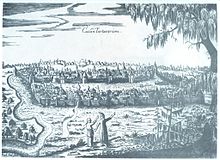

According to the official version adopted today, the city was founded more than 1,000 years ago. The estimated date of the urban settlement on the site of Kazan is 1004–1005 AD. The reason for this dating was found during excavations in the Kazan Kremlin – a Czech coin, dated by the Board of St. Wenceslaus (presumably, coinage 929–930 years) and the earliest Czech coin, the remains of masonry and wooden city fence, handicrafts and utensils (Hungarian type lining, women's beads, etc.), as well as other artifacts with less obvious dating. According to official statements, experts from 20 cities of Russia and 22 countries of the world were involved in the study of findings related to the age of Kazan.[23][24]
Kazan was a border post between Volga Bulgaria and two Finno-Ugric peoples—the Mari and Udmurt. Another question is where the citadel was built originally. Archaeological explorations have produced evidence of urban settlement in three parts of the modern city: in the Kremlin; in Bişbalta at the site of the modern Zilantaw monastery; and near the Kaban lake. The oldest of these seems to be the Kremlin.[citation needed]
After the Mongols ravaged the Bolğar and Bilär territories in the 13th century, the surviving Bulgars recovered in numbers and a small number of Kipchaks were assimilated from which they adopted their language (the so-called Bulgarism), or Kipchaks and Bulgars mixed to create a modern Kazan-Tatar population. Some Tatars also went to Lithuania, brought by Vytautas the great. Kazan became the center of the Principality, which was dependent on The Golden Horde. In the 13th and 14th centuries, Kazan was growing, becoming an important trade and political center within the Golden Horde. The growth of the city was also promoted by the successful geographical location at the intersection of major trade routes connecting East and West. During the same period, the minting of currency began with the indication of the place of minting—"Bulgar al-Jadid", that is, a New Bulgar.[25]
In 1438, the Bulgar fortress Kazan (ISKE-Kazan) was captured by the ousted Golden Horde Khan Ulugh Muhammad, who killed the local Prince Swan and moved the fortress to a modern place (according to Russian Chronicles). The city became the capital of the Khanate of Kazan. The city Bazaar, Taş Ayaq (stone foot) has become the most important shopping center in the region, especially for furniture. Handicraft production also flourished, as the city gained a reputation for its leather and gold products, as well as the wealth of its palaces and mosques. Kazan had trade relations with Moscow, Crimea, Turkey, and other regions.[citation needed]

As a result of the siege of Kazan in 1552, Tsar Ivan the Terrible conquered the city.[26] During the subsequent governorship of Alexander Gorbaty-Shuysky, most of the Kazan's Tatar residents were forcibly Christianized or deported,[27] and Mosques and palaces were ruined.[26] The surviving Tatar population was moved to a place 50 kilometers (31 mi) away from the city and this place was forcibly settled by Russian farmers and soldiers. Tatars in the Russian service were settled in the Tatar Bistäse settlement near the city's wall. Later Tatar merchants and handicraft masters also settled there. During this period, Kazan was largely destroyed as a result of several great fires. After one of them in 1579, the icon Our Lady of Kazan was discovered in the city.[citation needed]
In the early 17th century, at the beginning of the Time of Troubles in Russia, the Tsardom of Kazan declared independence under the leadership of voyvoda Nikanor Shulgin with the help of the Russian population, but this independence was suppressed by Kuzma Minin in 1612.[citation needed]

In 1708, the Tsardom of Kazan was abolished, and Kazan became the seat of Kazan Governorate. After Peter the Great's visit, the city became a center of shipbuilding for the Caspian fleet. The major Russian poet Gavrila Derzhavin was born in Kazan in 1743, the son of a poor country squire of Tatar ancestry though himself having a thoroughly Russian identity.
Before the building of modern dams, low-lying areas were regularly flooded in April and May. Kazan suffered major fires in 1595, 1672, 1694, 1742, 1749, 1757, 1774, 1815, and 1842.
Kazan was largely destroyed in 1774 as a result of Pugachev's rebellion, an uprising by border troops and peasants led by the Don Cossack ataman (Captain) Yemelyan Pugachev, but the city, formerly largely of timber construction, was soon afterwards rebuilt, using stone and according to a grid pattern plan, during the reign of Catherine the Great. Catherine also decreed that mosques could again be built in Kazan, the first being Marjani Mosque.

At the beginning of the 19th century Kazan State University and printing press were founded by Alexander I. It became an important center for Oriental Studies in Russia. The Qur'an was first printed in Kazan in 1801. Kazan became an industrial center and peasants migrated there to join its industrial workforce. In 1875, a horse tramway appeared; 1899 saw the installation of a tramway. After the Russian Revolution of 1905, Tatars were allowed to revive Kazan as a Tatar cultural center. The first Tatar theater and the first Tatar newspaper appeared.
In 1917, Kazan became one of the revolution centers. In 1918, Kazan was the capital of the Idel-Ural State, which was suppressed by the Bolshevik government. In the Kazan Operation of August 1918, it was briefly occupied by Czechoslovak Legions. In 1920, Kazan became the center of Tatar Autonomous Soviet Socialist Republic. After the Treaty of Rapallo (1922) until 1933, the German and the Russian army operated together the Kama tank school in Kazan.
During World War II, many industrial plants and factories to the west were relocated in Kazan, making the city a center of the military industry, producing tanks and planes. After the war Kazan consolidated as an industrial and scientific center. In 1979, the city's population reached one million.


In the late 1980s and in the 1990s, after the dissolution of the Soviet Union, Kazan again became the center of Tatar culture and identity, and separatist tendencies intensified. With the return of capitalism, Kazan became one of the most important centers of the Russian Federation. The city went from 10th to 8th position in population ranking of Russian cities. In the early 2000s, the city earned the right to host both the 2013 Summer Universiade and 2018 FIFA World Cup.
Millennium of Kazan

Since 2000, the city has been undergoing a total renovation. The historical center including the Kremlin was rebuilt, however a large number of the city's historical districts were completely demolished in the renovation. Kazan celebrated its millennium in 2005, after a city-organized historical commission settled on 1005 as the official year of the city's founding.[2] During the millennium celebrations, one of the largest mosque in Russia, Qolsharif, was dedicated in the Kazan Kremlin, the holiest copy of Our Lady of Kazan was returned to the city, the Millennium Bridge was inaugurated that year,[28] and the Kazan Metro began operation. The government of the Russian Federation released the Medal "In Commemoration of the 1000th Anniversary of Kazan".
In 2010, for the preparations to the 2013 Universiade, Kazan began even more renovation by modernizing its airport, fixing the streets, enhancing public transport, and adopting Russian, English, and Tatar languages in all transportation, large stores, and shopping centers.[citation needed]
In 2021, a teenager killed nine people in a school mass shooting and bombing.[29]
The historical symbol of Kazan is the mythical dragon-like creature Zilant, often mentioned in legends. For example, when numerous snakes and reptiles severely hampered the development of the city, the hunters went in search of the King of snakes and defeated him, according to another version, the residents of the city bought off the giant snake with gold, after which all the snakes left the city. Another legend says that the giant dragon-like serpent always guarded the Khan's treasures, and that it still protects the hidden wealth before the capture of the city in the secret caves. Historically, it is true that snakes were once numerous in the Kazan region, but then their number has decreased dramatically. The first official coat of arms of Kazan was approved on 18 October 1781 and was described as "black snake under the crown of gold, Kazan, red wings, white field". In 1926, the country introduced a ban on such heraldry. In the 1980s, the coat of arms of Kazan began to reappear, and in the 1990s Kazan Zilant in various styles began to appear in print media. Modern graphics of the emblem and flag appeared in 2005—in a silver field on the green earth a black dragon with red wings and tongue, with gold paws, claws and eyes, topped with a gold crown. The shield is crowned with a Kazan cap. According to the traditions of heraldry, the dragon symbolizes power, wisdom and invincibility, the earth—life and wealth, the crown-development, and the cap above the shield-the capital of the city.[30][31]
Kazan is the capital of Tatarstan. Within the framework of administrative divisions, it is incorporated as the city of republic significance of Kazan—an administrative unit with the status equal to that of the districts.[1] As a municipal division, the city of republic significance of Kazan is incorporated as Kazan Urban Okrug.[9]

Kazan is divided into seven districts:
| No. | District | Population[6] | Area (km2)[citation needed] |
|---|---|---|---|
| 1 | Aviastroitelny | 111,405 | 38.91 |
| 2 | Vakhitovsky | 86,202 | 25.82 |
| 3 | Kirovsky | 109,125 | 108.79 |
| 4 | Moskovsky | 130,537 | 38.81 |
| 5 | Novo-Savinovsky | 202,997 | 20.66 |
| 6 | Privolzhsky | 227,755 | 115.77 |
| 7 | Sovetsky | 275,514 | 167.00 |


Kazan is one of the largest industrial and financial centers of Russia, and a leading city of the Volga economic region in construction and accumulated investment.[32] The city's gross regional product was 380 billion rubles in 2011.[33]
Total banking capital of Kazan banks is third in Russia.[citation needed] The main industries of the city are: mechanical engineering, chemical, petrochemical, light and food industries. An innovative economy is represented by the largest IT-park in Russia which is one of the largest of its kind among Eastern European science parks.[34][35] Kazan ranked 186th in Mercer's 1999 Worldwide Quality of Living Survey.[36]
In 2011, city organisations and businesses attracted more than 87 billion rubles for economy and social sphere development. This was 44% more than in 2010. In 2014, businesses attracted 86 billion rubles. Most of them have been implemented in the real economy sector.
Because of the unstable economic situation within the country, there was a decrease of investment rates in 2015 and—according to the statistics of the first part of the year—it composed 51684.2 million rubles.
There are head offices of six companies that are in the top 500 in terms of revenues in Russia. The total area of city business centres is 330 thousand square metres.
Innovative economy in Kazan is represented by the biggest IT-park in Russia and also the biggest technical park in Europe. The only online platform for governmental trade except the Moscow one is operated in Kazan. During the post-Soviet period Kazan was the leader in terms of house construction in the Volga region, and now it holds the position and implements the Republican program of liquidation of dilapidated housing which was unique for Russia.
According to Forbes, Kazan was ranked 15th among the "Best cities for business in Russia" of 2010.[37] In 2012, Kazan ranked 6th in the quality of city environment rating, which was made by the Russian Federation Ministry of Regional Development, Russian Alliance of Engineers, Federal Construction Agency, Federal Service of Supervision of Consumer Protection and Welfare and Moscow Federal University.[38]

The first bus routes in Kazan came to use in 1925.[39] The bus is the most popular type of public transport in Kazan: in 2016, it carried about 74% of passengers. As of 2017, there are about 62 bus routes in the city,[40] with a total length of more than 1.2 thousand km. The total number of buses operating on city routes is 840. The movement of all buses is monitored using an automated control system based on satellite navigation.[41] Any Internet user can track the movement of buses.
Kazan's bus system was totally renovated in 2007. 62 routes have an aggregate length of 1,981 km (1,231 mi). All 1,444 buses are colored red. Half of the buses are imported, produced by Golden Dragon, Higer, MAZ, Yutong, and Hyundai. Other buses are mostly Russian made NefAZ.
The fare is 42 rubles in cash, 38 rubles by credit card and by a special transport card (as of Jan 2024). On the routes, conductors are involved and, in addition to paying for cash (with a higher fare), there are general civil (with different tariff plans for replenishment, including time passes and an "electronic wallet"), as well as preferential electronic transport cards.

Kazan's tram system is one of the oldest tram systems in Russia, opened on 20 November 1899. The tram system in Kazan consists of eight operating routes, one of which is a historical excursion route between the railway station and river port. The daily output is 87 trams. Most of the tram lines are laid along the axis of the main streets, most of them on a dedicated track, fenced with side stones. The tram in the city center was largely removed in the 2000s due to the fight against traffic jams on narrow streets; some routes turned out to be unprofitable after the optimization of the transport scheme in 2006–2007.
In 2009–2020, the reconstruction of tram tracks on the main highways was carried out, as well as the construction of four new tram lines, which made it possible to launch circular tram routes No. 5/5a with an accelerated mode of movement in 2012-2020 along the sections of the Big Kazan Ring.
All trams are equipped with autoinformators, announcements in which are in three languages (Russian, Tatar, English), for this reason announcements are played for a very long time (up to one and a half minutes). The fare is 42 rubles in cash, 38 rubles for an electronic card (2024). On the routes, conductors are involved and, in addition to paying for cash (with a higher fare), there are general civil (with different tariff plans for replenishment, including time passes and an "electronic wallet"), as well as preferential electronic transport cards.
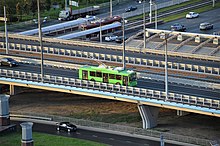
Kazan's trolleybus system is one of the oldest in Russia. Operation opened on 27 November 1948. In recent years, it continues to develop: new lines were launched, built and planned, while some new trolleybus lines replaced the removed tram lines. Two trolleybus depots operate a fleet of over 200 trolleybuses, all of which are green,[42] and serve 10 routes with a total length of 359.9 km (223.63 mi).[43] A major overhaul (CWR) of old trolleybuses was carried out at the Kazan aircraft plant KAPO for the city at the beginning of the 21st century.
As of June 2024, the fare is 42 rubles in cash or 38 rubles by electronic transportation card or debit card.[44] On the routes, conductors are involved and, in addition to paying for cash (with a higher fare), there are general civil (with different tariff plans for replenishment, including time passes and an "electronic wallet"), as well as preferential electronic transport cards.
All trolleybuses are monitored by an automated control system based on satellite navigation. Any Internet user can track the movement of trolleybuses.
A single-line Kazan Metro (running north to south-east) opened on 27 August 2005. As of 2024, the Kazan Metro had eleven stations and crossed the Kazanka River. A second metro line is being built (Feb 2024).
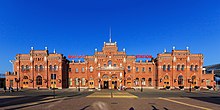
Kazan is connected with Moscow, Ulyanovsk, Yoshkar-Ola and Yekaterinburg by train.
The main railway station Kazan–Passazhirskaya is located in the city centre and includes a main building (built in 1896), a commuter trains terminal, a ticket office building and some other technical buildings. The station serves 36 intercity trains,[45] and more than eight million passengers per annum. The second terminus called "Kazan-2" is situated in the northern part of the city. Kazan also has 19 platforms for commuter trains. In addition, within the city there are also 24 railway stations and stopping platforms.[citation needed]
Payment is received in cash, by dedicated travel cards and by banking cards. One ride fee is 36 rubles in cash or by banking card and 35 rubles by travel card.[46] There are various plans for different types of travel which reduce single ride fees. There are no zoning tariffs within the city.[citation needed]
On 1 July 2013, the Veli'k bicycle sharing system was launched in Kazan. In total, the system includes seven self-service bicycle docking stations, and a total fleet of 100 bikes. The service is open to anyone from 16 years of age. There are three types of subscription – monthly, weekly and daily. During the season from late spring to mid-autumn, residents and guests of Kazan typically use the service more than 15,000 times. In 2015, the first cycle routes on separate bike lanes were opened in the city centre; further expansion is planned throughout the city.[citation needed]

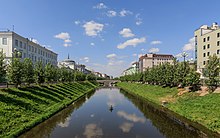
Kazan's river port is one of the largest on the Volga, thanks to the system of canals from which Kazan is sometimes called the "port of five seas". The main building of the river station was built together with the new river port by the early 1960s and renovated in 2005. The station serves both passengers of intercity cruise ships and commuter boats (including high-speed fleet) – to the Kamsky Ustye, Tetyush, Bolgar, Pechishch, Sviyazhsk and Sadovaya. The daily passenger traffic in the summer period is up to 6 thousand people per day. In winter, Pneumocushion boats are used, it goes from Kazan to Verkhny Uslon.[47][48]
There are federal highway connections to Moscow and Ufa (E-22), Orenburg (R-239), Ulyanovsk (R-241) and Igra (R-242). There are also the R-175 federal highway and "Northern Europe – Western China" (in construction) route near the city.[citation needed]
There are five bridges across the Kazanka (Qazansu) river in the city, and one bridge connecting Kazan with the opposite bank of the Volga.
There are two bus stations in Kazan—Central and Southern. Bus routes connect Kazan with all districts of Tatarstan, Samara, Ufa, Tolyatti, Orenburg, Ulyanovsk, Cheboksary, Sterlitamak, Buzuluk, and Aktobe.[citation needed]
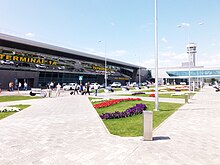
Kazan International Airport is located 26 kilometers (16 mi) from the city center. It is a hub for UVT Aero and Kazan Air Enterprise and hosts eleven air companies. The airport is connected with the city by bus route #97 and by a suburban train line. There is also the Kazan Borisoglebskoye airfield, home to Kazan Aircraft Production Association, a major aircraft factory, famous in the past as "Aircraft Plant 22" ("22nd Zavod").[citation needed]
Adjacent to it lies a huge aircraft engines plant ("16th Zavod"). It produces versions of Tupolev 204 and 214 aircraft. In the past an Ilyushin-62, four-engine Russian mainliner, Tupolev-160 "Black Jack" supersonic strategic bomber and Tu-22M tactic bomber were also produced here. Both these plants and adjacent workers' housing make a whole city district known as "Aviastroitelny" ("Aircraft Builders").[citation needed]
| Year | Pop. | ±% |
|---|---|---|
| 1897 | 130,000 | — |
| 1926 | 175,597 | +35.1% |
| 1939 | 398,014 | +126.7% |
| 1959 | 646,806 | +62.5% |
| 1970 | 868,537 | +34.3% |
| 1979 | 992,675 | +14.3% |
| 1989 | 1,094,378 | +10.2% |
| 2002 | 1,105,289 | +1.0% |
| 2010 | 1,143,535 | +3.5% |
| 2021 | 1,308,660 | +14.4% |
| Source: Census data | ||


Population: 1,308,660 (2021 Census);[49] 1,143,535 (2010 Census);[6] 1,105,289 (2002 Census);[50] 1,094,378 (1989 Soviet census).[51] Kazan metropolitan area's population is 1.8 million.
As of 2021, the ethnic composition of Kazan was:[52]
| Ethnicity | Population | Percentage |
|---|---|---|
| Tatars | 608,519 | 48.8% |
| Russians | 584,232 | 46.9% |
| Chuvash | 9,470 | 0.8% |
| Uzbeks | 6,473 | 0.5% |
| Others | 37,285 | 3.0% |
The city's population consists mostly of ethnic Tatars (48.8%) and ethnic Russians (46.9%). Other ethnicities include Chuvash, Uzbeks, Tajiks, Azerbaijanis and Mari.
Religion in Kazan (2024)
Predominant faiths of Kazan city are Islam and Eastern Orthodox Christianity,[53] with minority representation of Roman Catholicism, Protestantism, Judaism, and the Baháʼí Faith.
The most spoken language in Kazan is Russian, and the Tatar language is the second most spoken.[citation needed]
| Kazan | ||||||||||||||||||||||||||||||||||||||||||||||||||||||||||||
|---|---|---|---|---|---|---|---|---|---|---|---|---|---|---|---|---|---|---|---|---|---|---|---|---|---|---|---|---|---|---|---|---|---|---|---|---|---|---|---|---|---|---|---|---|---|---|---|---|---|---|---|---|---|---|---|---|---|---|---|---|
| Climate chart (explanation) | ||||||||||||||||||||||||||||||||||||||||||||||||||||||||||||
| ||||||||||||||||||||||||||||||||||||||||||||||||||||||||||||
| ||||||||||||||||||||||||||||||||||||||||||||||||||||||||||||
Kazan has a humid continental climate (Köppen: Dfb) with long, cold winters (colder than Moscow), and warm, sunny summers. As a result of its far inland position, summers are extremely warm for its latitude and winters are quite cold compared to areas further west in Europe.[citation needed]
The warmest month is July with daily mean temperature near 20.2 °C (68.4 °F), and the coldest month is January, with a daily mean of −10.4 °C (13.3 °F).[citation needed]
The city set its two hottest days on record during the 2010 Northern Hemisphere summer heat waves. Temperatures reached +39 °C (102 °F) in the hottest days during that time.[54]
| Climate data for Kazan (1991–2020, extremes 1812–present) | |||||||||||||
|---|---|---|---|---|---|---|---|---|---|---|---|---|---|
| Month | Jan | Feb | Mar | Apr | May | Jun | Jul | Aug | Sep | Oct | Nov | Dec | Year |
| Record high °C (°F) | 4.5 (40.1) |
5.6 (42.1) |
15.8 (60.4) |
29.5 (85.1) |
33.5 (92.3) |
37.5 (99.5) |
38.9 (102.0) |
39.0 (102.2) |
32.3 (90.1) |
23.4 (74.1) |
15.0 (59.0) |
6.1 (43.0) |
39.0 (102.2) |
| Mean daily maximum °C (°F) | −7.1 (19.2) |
−6.3 (20.7) |
0.3 (32.5) |
10.5 (50.9) |
19.7 (67.5) |
23.6 (74.5) |
25.8 (78.4) |
23.5 (74.3) |
16.8 (62.2) |
8.5 (47.3) |
−0.3 (31.5) |
−5.4 (22.3) |
9.1 (48.4) |
| Daily mean °C (°F) | −10.0 (14.0) |
−9.7 (14.5) |
−3.3 (26.1) |
5.8 (42.4) |
14.0 (57.2) |
18.3 (64.9) |
20.5 (68.9) |
18.3 (64.9) |
12.3 (54.1) |
5.3 (41.5) |
−2.5 (27.5) |
−8.0 (17.6) |
5.1 (41.2) |
| Mean daily minimum °C (°F) | −12.8 (9.0) |
−12.7 (9.1) |
−6.5 (20.3) |
1.9 (35.4) |
9.0 (48.2) |
13.5 (56.3) |
15.8 (60.4) |
13.9 (57.0) |
8.7 (47.7) |
2.7 (36.9) |
−4.5 (23.9) |
−10.5 (13.1) |
1.5 (34.7) |
| Record low °C (°F) | −46.8 (−52.2) |
−39.9 (−39.8) |
−31.7 (−25.1) |
−27.2 (−17.0) |
−6.5 (20.3) |
−1.4 (29.5) |
2.6 (36.7) |
1.0 (33.8) |
−5.4 (22.3) |
−23.4 (−10.1) |
−36.6 (−33.9) |
−43.9 (−47.0) |
−46.8 (−52.2) |
| Average precipitation mm (inches) | 46 (1.8) |
37 (1.5) |
38 (1.5) |
34 (1.3) |
38 (1.5) |
57 (2.2) |
62 (2.4) |
55 (2.2) |
50 (2.0) |
54 (2.1) |
45 (1.8) |
50 (2.0) |
566 (22.3) |
| Average extreme snow depth cm (inches) | 30 (12) |
42 (17) |
44 (17) |
9 (3.5) |
0 (0) |
0 (0) |
0 (0) |
0 (0) |
0 (0) |
0 (0) |
5 (2.0) |
16 (6.3) |
44 (17) |
| Average rainy days | 3 | 2 | 4 | 11 | 15 | 18 | 16 | 16 | 18 | 17 | 10 | 5 | 135 |
| Average snowy days | 26 | 22 | 16 | 6 | 1 | 0 | 0 | 0 | 1 | 7 | 20 | 24 | 123 |
| Average relative humidity (%) | 84 | 80 | 76 | 67 | 58 | 65 | 68 | 70 | 75 | 80 | 85 | 84 | 74 |
| Mean monthly sunshine hours | 35.6 | 71.9 | 144.4 | 213.0 | 290.1 | 308.6 | 316.1 | 253.0 | 156.3 | 78.0 | 32.9 | 21.4 | 1,921.3 |
| Source 1: Погода и Климат[55] | |||||||||||||
| Source 2: NOAA[56] | |||||||||||||


The city has a citadel (Russian: кремль, tr. kreml', or sometimes Tatar: kirman), which was declared a World Heritage Site in 2000. Major monuments in the Kremlin are the five-domed, six-columned Annunciation Cathedral (1561–62) and the mysterious, formerly leaning Söyembikä Tower, named after the last queen of Kazan and regarded as the city's most conspicuous landmark.
Also of interest are the towers and walls, erected in the 16th and 17th centuries but later reconstructed; the Qol-Şarif Mosque, which has been rebuilt inside the citadel; remains of the Saviour Monastery (a 16th-century cathedral demolished by the Bolsheviks) with the Spasskaya Tower; and the Governor's House (1843–53), designed by Konstantin Thon, now the Palace of the President of Tatarstan.
Next door, the ornate baroque Sts-Peter-and-Paul's Cathedral on Qawi Nacmi Street and Marcani Mosque on Qayum Nasiri Street date back to the 18th century.
The Spasskaya Tower was built in two floors by 16th century Pskov architects Ivan Shiryai and Postnik Yakovlev. From the inside, the northern side of the fortress to the Spasskaya Tower adjoined the gate to Spasskaya Church, which has now merged with the tower. The typical Pskovian architectural elements of the facade face the main street of the Kremlin. At the end of the 17th century, instead of three tiers, the tower was built with two brick eight-sided tiers with a brick roof, getting its present, familiar appearance. Until 1917, the tower was crowned with the double-headed coat of arms of the Russian state. In the 18th century, a ringing clock was installed in the upper tier, and even earlier a large bell was moved from a small belfry (now lost, located on the castle wall on the left side of the tower). Until the middle of the 19th century, there was a moat with a stone bridge in front of the tower.
The South-Western Tower was built simultaneously with the Spasskaya tower by Pskov masters and is a classic example of the Pskov style of defensive structures.
The name of the Transfiguration Tower comes from the Transfiguration Monastery of the Savior, which was fenced from the north-west. The tower was also built by Pskov architects Postnik and Barma, but it was significantly rebuilt later, as it has strong traces of the architectural influence of the Moscow defensive architecture. The territory from the Transfiguration Tower to the Spasskaya pass was added to the old Khan's fortress by Pskov masters.
There are unnamed round brick towers, presumably built by Moscow architects in the 17th century.
The Tainitskaya Tower was built in its present form in the 1550s by Postnik Yakovlev. It was named after a secret source from which it was possible to take water during a siege. The entrance to the tower is in the form of a "knee", which increased the defense of the Kremlin. It replaced a tower from the time of the khanate, Nur Ali (in Russian transcription Muraleeva). The 22-year-old Tsar Ivan the Terrible entered the conquered city through the Nur Ali tower.
The North-Eastern Round Tower was demolished after the Pugachev's assault.
The Consistor Tower was built in brick by Moscow architects in the 17th century, its name was given in the 18th century from the Spiritual Consistory located near the tower in the Kremlin. Near the tower, archaeological excavations revealed the so-called Tezitsky (Arabic for "merchant") Moat, which went from the Consistor Tower to the Transfiguration. Archaeologist N. Kalinin and a number of scientists believed that the moat was the southern border of the Khan's fortress.
The Southeast Round Tower is an example of Pskov architecture of the 16th century.
Central Kazan is divided into two districts by the Bolaq canal and Lake Qaban. The first district (Qazan Bistäse or Kazanskiy Posad), historically Russian, is situated on the hill, the second (İske Tatar Bistäse or Staro-Tatarskaya Sloboda), historically Tatar, is situated between the Bolaq and the Volga. Mosques, such as Nurullah, Soltan, Bornay, Äcem, Märcani, İske Taş, Zäñgär are in the Tatar district.
Churches, such as Blagoveschenskaya, Varvarinskaya, Nikol'skaya, Tikhvinskaya, are mostly in the Russian part of the city.
The main city-centre streets are Bauman, Kremlyovskaya, Dzerzhinsky, Tuqay, Puşkin, Butlerov, Gorkiy, Karl Marx and Märcani.
In the beginning of the 1900s most of Central Kazan was covered by wooden buildings, usually consisting of two floors. There was a historical environment of Kazan citizens, but not the best place to live in. During the Republican program "The liquidation of ramshackle apartments" most of them (unlike other Russian cities), especially in Central Kazan, where the land is not cheap, were destroyed and their population was moved to new areas at the suburb of the city (Azino, Azino-2, Quartal 39). Nearly 100,000 citizens resettled by this programme.
Another significant building in central Kazan is the former "Smolentzev and Shmelev" tea house and hotel, now the Shalyapin Palace Hotel. It is located at 7/80 Universitetskaya Street, at the corner of Universitetskaya and Bauman. A major landmark of late-19th and early-20th century commercial architecture, it consists of two portions. The original portion, built for a merchant named Usmanov in the 1860s, was bought by the inter-related families of Efim Smolentzev and Pavel and Nikolai Shmelev in 1899.[57] They operated a store selling, among other things, tea. In 1910, the Smolentevs and Shmelevs constructed another portion, designed by architect Vasili Trifonov, and operated a hotel there.[58] After the Russian Revolution, the building eventually became the Hotel Soviet and after 2000 it was heavily renovated to reopen as the Shalyapin Palace Hotel.
Primary and secondary education system of Kazan includes[when?]:
There are also 49 music schools, 43 sports school, and 10 fine-arts schools, including the Kazan Art School founded in 1895.[citation needed]
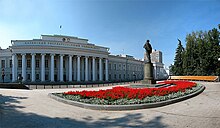
There are 44 institutes of higher education in Kazan, including 19 branches of universities from other cities. More than 140,000 students are educated in the city. Kazan Federal University (founded in 1804) is third oldest university in Russia after Saint Petersburg State University (1724) and Moscow State University (1755). In 2009 KFU got Federal status as main university of Volga Region. Some other prominent universities are:

Kazan is a major scientific centre in Russia. Kazan formed a big number of scientific areas and schools (mathematical, chemical, medical, linguistic, geological, geobotanical, etc.). Scientific discoveries are a subject of special pride, including: the creation of non-Euclidean geometry (Nikolai Lobachevsky), the discovery of the chemical element ruthenium (Karl Ernst Claus), the theory about the structure of organic compounds (Aleksandr Butlerov), the discovery of the electron paramagnetic resonance (Yevgeny Zavoisky) and acoustic paramagnetic resonance (Altshuler) and many others. The city hosts:



Kazan City Duma is a representative body of the city, elected every four years and holds its sessions in Kazan City Hall. The executive committee is a municipal body of the executive organs.[clarification needed] The committee's head is Denis Kalinkin.[61]
Agency works 84 post offices belonging to the branch of "Russian Post", UFPS "Tatarstan pochtasy". The official opening of the Kazan city telephone network took place on 27 (15) November 1888. At the moment, there are four operators of wired telephone in Kazan. The total capacity of the telephone network in Kazan is about 456,000 numbers. Services of IP-telephony operators in addition to the basic wired connection is also supported by the five companies.[62] The city has six mobile operators (Beeline, MegaFon, MTS, Tele2 Russia, Letai, Yota, and also operates virtual mobile operator "Mobile public communication"). By the number of Internet users—428 thousand people—Kazan takes the 4th place in Russia. According to the General Director of Google Russia Vladimir Dolgov, Kazan is the largest center of information technology development, the level of Internet penetration is 75%, which is a record figure for Russia. Access to the World Wide Web in Kazan is provided by 15 operators.[63] The most popular forms of Internet access are cable networks and ADSL. Previously popular Dial-up has almost lost its position, at the same time actively developing wireless technology Wi-Fi and Wi-Max. Scartel launched the first LTE network in Russia.[64]
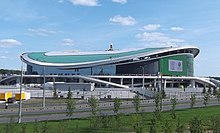


Kazan now is one of the most developed cities in Russia in terms of sport. The city has hosted two Bandy World Championships, in 2005 and 2011, the World Summer Universiade 2013, the World Championship in fencing in 2014, the Aquatics Championship FINA 2015, 2017 FIFA Confederations Cup, 2018 FIFA World Cup and other international competitions of various levels.
Men's teams:
| Club | Sport | Founded | Current league | League rank |
Stadium |
|---|---|---|---|---|---|
| Rubin Kazan | Football | 1958 | Russian Premier League | 1st | Kazan Arena |
| Ak Bars Kazan | Ice Hockey | 1956 | Kontinental Hockey League | 1st | Tatneft Arena |
| Bars Kazan | Ice Hockey | 2009 | Minor Hockey League | Jr. 1st | Tatneft Arena |
| Irbis Kazan | Ice Hockey | 2011 | Minor Hockey League Division B | Jr. 2nd | Tatneft Arena |
| Dynamo-Kazan | Bandy | 1958 | Bandy Super League | 1st | Raketa Stadium |
| UNICS Kazan | Basketball | 1991 | Professional Basketball League | 1st | Basket-Hall Arena |
| Zenit Kazan | Volleyball | 2000 | Volleyball Super League | 1st | Kazan Volleyball Centre |
| Sintez Kazan | Water Polo | 1974 | Water Polo Championship | 1st | Orgsintez |


Kazan is actively engaged in international activities. The city has foreign diplomatic, trade and cultural representations, the Kazan Kremlin and the Institute of culture of peace are under the auspices of UNESCO, the city participates in partner movements, is a member of the world organizations of cities. The summit of the CIS heads, the Summit of the world security services and other important forums, conferences and events of the world level were held in Kazan. The head of China, the US Secretary of State, about three dozen presidents and Prime Ministers of foreign States paid visits to the capital of the Republic, as to few other cities of the country. Renovated in 2005, the international airport provides flights to dozens of cities in different countries, including the largest airliners (class Boeing 747), and is gradually being rebuilt into a potential hub for the Universiade 2013 and the World Cup 2018; international rail links from the city.
Kazan is home to six consulates general.[66]
Kazan has also partner relations with the following cities and regions:

The Russian television drama The Boy's Word: Blood on the Asphalt is set in 1980s Soviet Kazan.